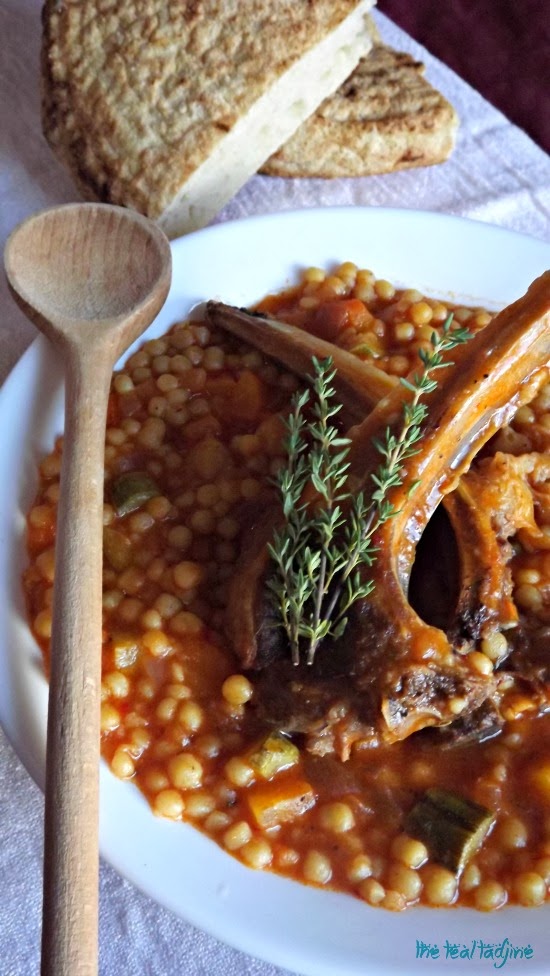بِسْــــــــــــــــــــــمِ اﷲِارَّحْمَنِ ارَّحِيم
السلام عليكم و رحمة الله و بركاته
The temperature in my area dropped to very bone chilling 10°C. While that's not too bad for many parts of the world, for the Algerian coast it's cold. I froze most of the day, nosing runny and I think I'm even coming down with a cold. I'm not against cold weather. I spent half my life living in cold climates. Each season has some ascepts that I love and appreciate, but Algeria stays usually mild most of the year where. We don't even need the heater on. But last night and today, we were definitely cold enough and we turned on the heater.
There are a few things about cold weather that I do love. Having reason to turn on the oven and bake something. The double win of the feeling extra comfy and warm Pashmina Cashmere scarf and thick woolen socks. And lastly stew. There is something incredibly comforting about sitting down at the table with a giant bowl of steaming stew and a crusty loaf of bread.
Bekoukés in a slightly spicy red sauce is mostly consumed by the winter cold weather in most Algerian households, including my own. The base of this dish pretty much the same, with some slightly different according to which meat you choose to use. Berkoukés can be made with beef, lamb, or chicken, and in Kabylia they often add a dried meat called Quedid to enchance the rich earthy flavors of this dish. In fact, like all rustic dishes, it uses traditional preserves prepared in advance by the farmers to face the cold of winter!
P.S. If you're looking for more warming winter dishes ... just click here!
Bekoukés is REAL comfort food for Algerians. I've heard many stories from my husband about his mom's Berkoukés and all the wonderful memories surrounding it.
Today, I made Berkoukés for my family using some lamb rib chops I hadn't used from Eid al Adha's sacrifical sheep. I added a handful of dried apricots. A little something I learned from my late mother-n-law'
. The apricots give a slight earthy sweetness that goes nicely with the lamb and spices. I would recommend making this addition.
Traditionally, bekoukés is partially steamed in a couscousier then added to the meat sauce to cook further. Personally, I find cooking the berkoukés in the sauce along with the meat imparts a much better taste with less steps. LLess work in the kitchen is always a good thing. If you want to go traditional, simply steam the berkoukés in a couscousier or steam insert until al dente - same way you steam couscous, then add into the sauce. Berkoukés can be as dry or saucey, depending on your taste. Personally, I like mine to have some sauce to it. Nothing is worse to me then a dry pasta. If you like it with more liquid like a soup, there's a soup using Berkoukés I'll be sharing later on. So stay tuned!
On this really cold this was delicious. It also re-heated well the next day served alone in a bowl with crusty bread pretty good!
whAT'S YOUR FAVORITE BOWL OF COMFORT?
Let's keep in touch! Sign up for posts delivered right to your e-mail inbox or subscribe to my feed. You can also 'like' me on Facebook, pin posts on Pinterest or follow me on Twitter for all the latest recipes and updates.
share this on









Hello for the first time from south of Sydney in Australia, at the moment home of heatwaves of 4-5 days or more of 40-43 C as we head towards end of summer [as my min winter weather here is - 2 C, 10 C is cold for me too :) !]. Loved your recipe which I'll copy faithfully when days a little cooler, [with Israeli couscous I am afraid] to try and replicate your tastes. Love the couscous and chickpeas together! Thanks!!
ReplyDeleteHello Eha, Thank you for stopping by and commenting. It still boggles my mind how different the climates are in the world - here it is slightly windy and cool, to the north of us it's freezing and where you are it's a heat wave! Gotta appreciate the creation (of God).
ReplyDeleteThis dish, yes it can be made with Israeli couscous or even the Italian pasta acni de pipi - with all of these work just fine as far as taste. :D Have a great day!